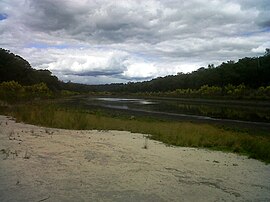HD 93905
HD 93905| 관찰 데이터 Epoch J2000 Equinox J2000 | |
|---|---|
| 콘스텔레이션 | 앤틀리아 |
| 적경 | 10h 49m 57.0188s[1] |
| 적위 | - 34° 03° 29.4506°[1] |
| 겉보기 등급(V) | 5.61[2] |
| 특성. | |
| 진화 단계 | 주계열[3] |
| 스펙트럼형 | A1 V[4] |
| U-B 색지수 | +0.05[5] |
| B-V 색지수 | +0.04[5] |
| 아스트로메트리 | |
| 반지름 속도(Rv) | - 9.5±1.3km[6]/s |
| 고유운동(μ) | RA: - 41.069[1] mas/년 Dec.: +5.845[1] mas/년 |
| 시차()) | 8.7989 ± 0.1617 mas[1] |
| 거리 | 371 ± 7 년 (표준 ± 2 pc) |
| 절대 등급(MV) | 0.00[2] |
| 상세[3] | |
| 덩어리 | 2.78±0.05 M☉ |
| 반지름 | 3.89[7] R☉ |
| 광도 | 101±9 L☉ |
| 표면 중력(log g) | 3.77[8] 킬로그램 |
| 온도 | 8995+125 −123 K |
| 회전 속도(v sin i) | 85[9] km/s |
| 나이 | 256±6 미르 |
| 기타 명칭 | |
| 데이터베이스 참조 | |
| 심바디 | 데이터. |
HD 93905(HR 4238)는 남쪽 안틀리아자리에 있는 단독 별입니다.이 별의 절대 등급은 0이고[2] 겉보기 등급은 5.[2]61로 이상적인 조건에서 육안으로 희미하게 보인다.이 별은 시차 편이를 기준으로 371광년[1] 떨어진 곳에 있으며 -9.6km/[6]s의 헬로센터 반경 속도로 더 가까이 표류하고 있다.
이 별의 분류는 A1 [4]V로 중심핵에서 수소를 융합하는 일반적인 A형 주계열성임을 나타낸다.현재 이 별의 질량은 태양의[3] 2.78배이지만 반지름과 광도는 각각 태양의[7] 3.89배와[3] 101배로 등급에 비해 크고 지나치게 밝다.이는 HD 93905가 2억5천600만 [3]년의 나이에 주계열 수명 대부분을 이미 마쳤기 때문이다.HD 93905는 표면온도가 8,895K이며[3] 85km/[9]s의 회전속도로 빠르게 회전한다.
레퍼런스
- ^ a b c d e f VizieR에서 이 소스에 Brown, A. G. A.; et al. (Gaia collaboration) (August 2018). "Gaia Data Release 2: Summary of the contents and survey properties". Astronomy & Astrophysics. 616. A1. arXiv:1804.09365. Bibcode:2018A&A...616A...1G. doi:10.1051/0004-6361/201833051.대한 Gaia DR2 레코드.
- ^ a b c d Anderson, E.; Francis, Ch. (May 2012). "XHIP: An extended hipparcos compilation". Astronomy Letters. 38 (5): 331–346. arXiv:1108.4971. Bibcode:2012AstL...38..331A. doi:10.1134/S1063773712050015. ISSN 1063-7737. S2CID 119257644.
- ^ a b c d e f Zorec, J.; Royer, F. (January 2012). "Rotational velocities of A-type stars: IV. Evolution of rotational velocities". Astronomy & Astrophysics. 537: A120. arXiv:1201.2052. Bibcode:2012A&A...537A.120Z. doi:10.1051/0004-6361/201117691. ISSN 0004-6361.
- ^ a b Houk, N. (1982). Michigan Catalogue of Two-dimensional Spectral Types for the HD stars. Volume_3. Declinations -40_ƒ0 to -26_ƒ0. Bibcode:1982mcts.book.....H.
- ^ a b Johnson, H. L.; Mitchell, R. I.; Iriarte, B.; Wisniewski, W. Z. (1966). "UBVRIJKL Photometry of the Bright Stars". Communications of the Lunar and Planetary Laboratory. 4: 99–110. Bibcode:1966CoLPL...4...99J.
- ^ a b Gontcharov, G. A. (November 2006). "Pulkovo Compilation of Radial Velocities for 35 495 Hipparcos stars in a common system". Astronomy Letters. 32 (11): 759–771. arXiv:1606.08053. Bibcode:2006AstL...32..759G. doi:10.1134/S1063773706110065. ISSN 1063-7737. S2CID 119231169.
- ^ a b McDonald, I.; Zijlstra, A. A.; Watson, R. A. (11 October 2017). "Fundamental parameters and infrared excesses of Tycho–Gaia stars". Monthly Notices of the Royal Astronomical Society. 471 (1): 770–791. arXiv:1706.02208. Bibcode:2017MNRAS.471..770M. doi:10.1093/mnras/stx1433. ISSN 0035-8711.
- ^ Anders, F.; et al. (August 2019). "Photo-astrometric distances, extinctions, and astrophysical parameters for Gaia DR2 stars brighter than G = 18". Astronomy & Astrophysics. 628: A94. arXiv:1904.11302. Bibcode:2019A&A...628A..94A. doi:10.1051/0004-6361/201935765. ISSN 0004-6361.
- ^ a b Royer, F.; Zorec, J.; Gómez, A. E. (February 2007). "Rotational velocities of A-type stars: III. Velocity distributions". Astronomy & Astrophysics. 463 (2): 671–682. arXiv:astro-ph/0610785. Bibcode:2007A&A...463..671R. doi:10.1051/0004-6361:20065224. ISSN 0004-6361.



